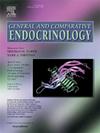Crosstalk between prolactin, insulin-like growth factors, and thyroid hormones in feather growth regulation in neonatal chick wings
IF 1.7
3区 医学
Q3 ENDOCRINOLOGY & METABOLISM
引用次数: 0
Abstract
The elongation of primary feathers in neonatal chicks is delayed by the late-feathering K gene located on the Z chromosome. We recently found that the K gene slows feather growth by reducing the number of functional prolactin (PRL) receptor (PRLR) dimers. In this study, we investigated the molecular mechanisms by which PRL promotes feather elongation. RT-qPCR and immunohistochemistry analyses revealed that PRLRs are predominantly localized in the pulp rather than in the epidermal layer of the feather follicle. Treatment of primary cultured feather pulp cells with PRL increased the expression of mRNAs for insulin-like growth factors (IGFs; IGF-1 and IGF-2) and type 2 deiodinase (DIO2). Furthermore, treatments with IGF-1 and triiodothyronine (T3) reciprocally enhanced the expression of mRNAs for DIO2 and IGFs. Additionally, BrdU staining in neonatal chicks showed that T3 promoted cell proliferation in both the epidermal layer and pulp cells, while this effect was suppressed by an IGF-1 receptor (IGF1R) inhibitor. These findings suggest a novel model in which PRL upregulates IGFs and DIO2 in feather pulp cells, creating a positive feedback loop between IGFs and T3, ultimately leading to the promotion of cell proliferation in both the epidermal layer and the pulp cells by IGFs. This is the first report proposing crosstalk between PRL, thyroid hormone (TH), and IGFs in feather follicles.
泌乳素、胰岛素样生长因子和甲状腺激素在雏鸡羽翼羽毛生长调节中的串扰。
初生雏鸡初生羽毛的伸长是由位于Z染色体上的迟生羽毛K基因延迟的。我们最近发现K基因通过减少功能性催乳素(PRL)受体(PRLR)二聚体的数量来减缓羽毛的生长。在这项研究中,我们研究了PRL促进羽毛伸长的分子机制。RT-qPCR和免疫组织化学分析显示,prlr主要分布在毛毛囊的髓质而不是表皮层。用PRL处理原代培养的羽髓细胞可增加胰岛素样生长因子(IGFs) mrna的表达;IGF-1和IGF-2)和2型脱碘酶(DIO2)。此外,用IGF-1和三碘甲状腺原氨酸(T3)处理可以相互增强DIO2和igf mrna的表达。此外,新生雏鸡的BrdU染色显示,T3促进了表皮层和髓细胞的增殖,而这种作用被IGF-1受体(IGF1R)抑制剂抑制。这些发现提示了一个新的模型,PRL上调羽髓细胞中的IGFs和DIO2,在IGFs和T3之间形成一个正反馈回路,最终导致IGFs促进表皮层和羽髓细胞的细胞增殖。这是首次报道羽毛毛囊中PRL、甲状腺激素(TH)和igf之间存在串扰。
本文章由计算机程序翻译,如有差异,请以英文原文为准。
求助全文
约1分钟内获得全文
求助全文
来源期刊

General and comparative endocrinology
医学-内分泌学与代谢
CiteScore
5.60
自引率
7.40%
发文量
120
审稿时长
2 months
期刊介绍:
General and Comparative Endocrinology publishes articles concerned with the many complexities of vertebrate and invertebrate endocrine systems at the sub-molecular, molecular, cellular and organismal levels of analysis.
 求助内容:
求助内容: 应助结果提醒方式:
应助结果提醒方式:


